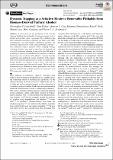Dynamic trapping as a selective route to renewable phthalide from biomass-derived furfuryl alcohol
Abstract
A novel route for the production of the versatile chemical building block phthalide from biorenewable furfuryl alcohol and acrylate esters is presented. Two challenges that limit sustainable aromatics production via Diels–Alder (DA) aromatisation—an unfavourable equilibrium position and undesired regioselectivity when using asymmetric addends—were addressed using a dynamic kinetic trapping strategy. Activated acrylates were used to speed up the forward and reverse DA reactions, allowing for one of the four DA adducts to undergo a selective intramolecular lactonisation reaction in the presence of a weak base. The adduct is removed from the equilibrium pool, pulling the system completely to the product with a fixed, desired regiochemistry. A single 1,2-regioisomeric lactone product was formed in up to 86 % yield and the acrylate activating agent liberated for reuse. The lactone was aromatised to give phthalide in almost quantitative yield in the presence of Ac2O and a catalytic amount of strong acid, or in 79 % using only catalytic acid.
Citation
Lancefield , C S , Fölker , B , Cioc , R C , Stanciakova , K , Bulo , R E , Lutz , M , Crockatt , M & Bruijnincx , P C A 2020 , ' Dynamic trapping as a selective route to renewable phthalide from biomass-derived furfuryl alcohol ' , Angewandte Chemie - International Edition , vol. Early View . https://doi.org/10.1002/anie.202009001
Publication
Angewandte Chemie - International Edition
Status
Peer reviewed
ISSN
1433-7851Type
Journal article
Description
R.B. acknowledges the Netherlands Organization for Scientific Research (NWO) (Vidi 723.012.104). C.S.L. thanks the Leverhulme Trust Early Career Fellowship (ECF‐2018‐480). We also acknowledge the NWO for funding the X‐ray diffractometer used in this study. K.S. acknowledges financial support from The Netherlands Centre for Multiscale Catalytic Energy Conversion (MCEC).Collections
Items in the St Andrews Research Repository are protected by copyright, with all rights reserved, unless otherwise indicated.

